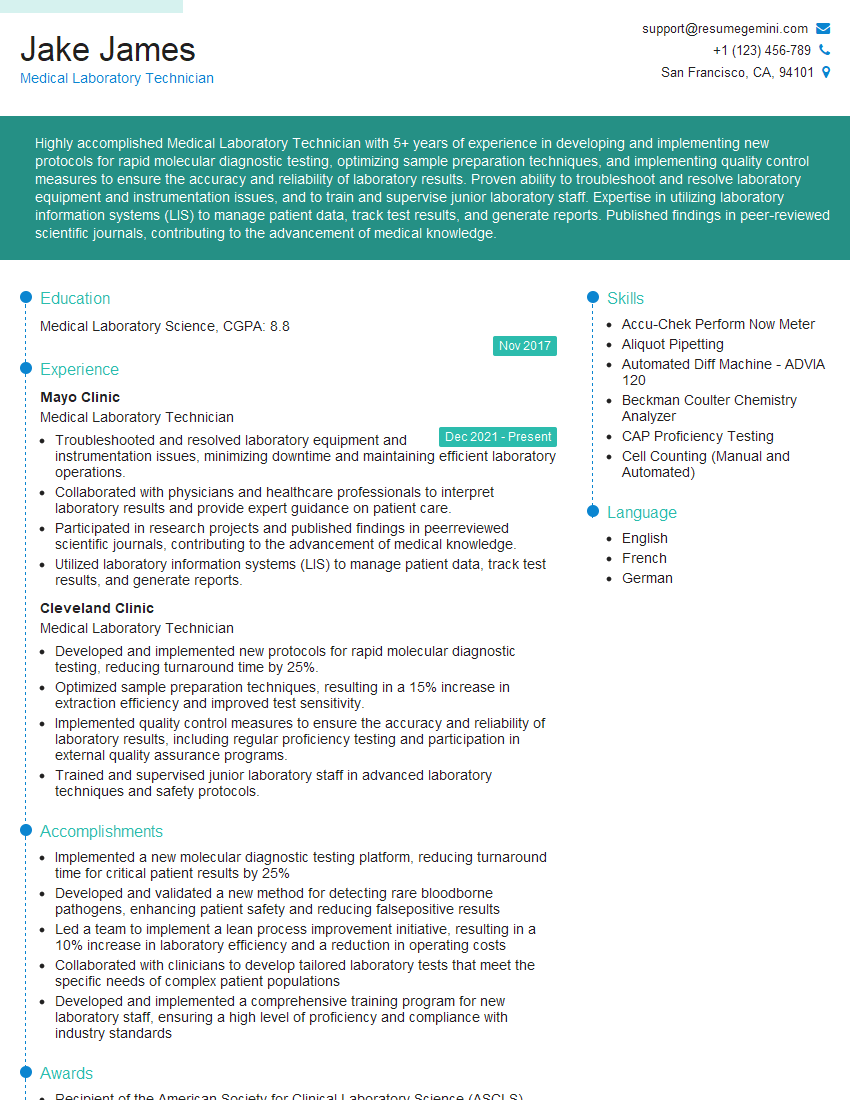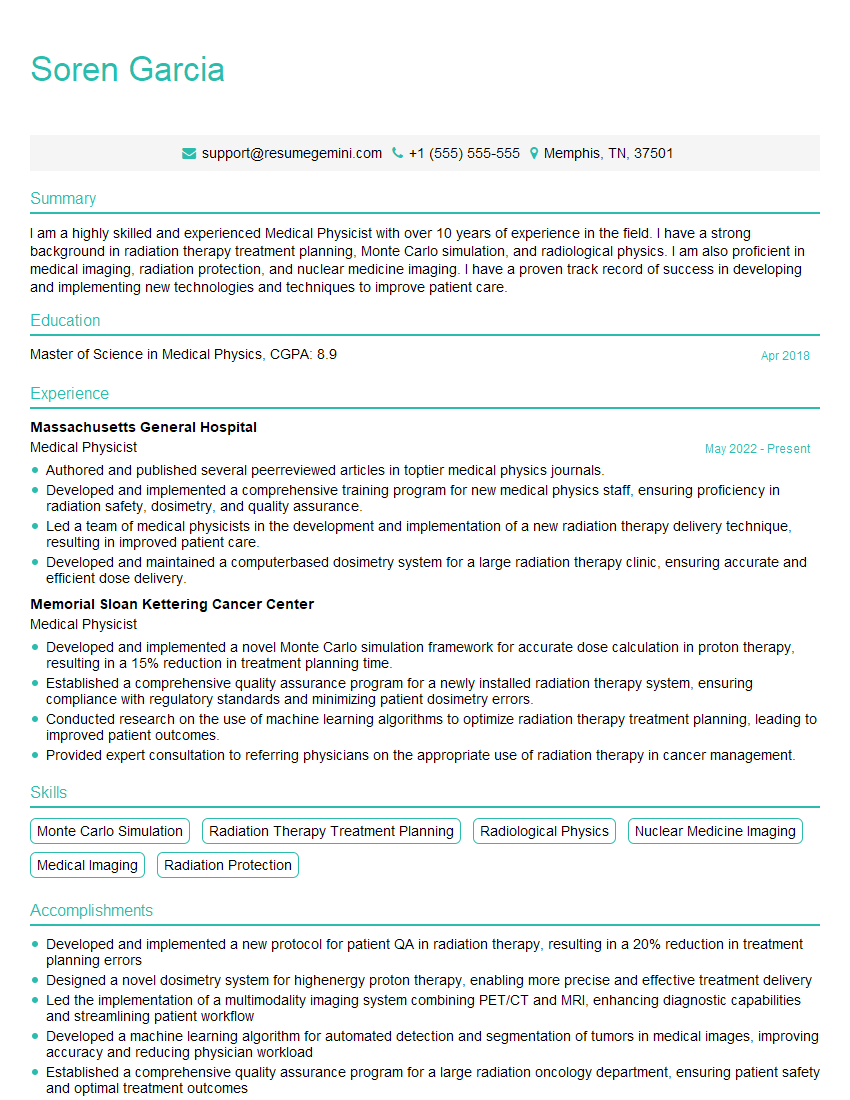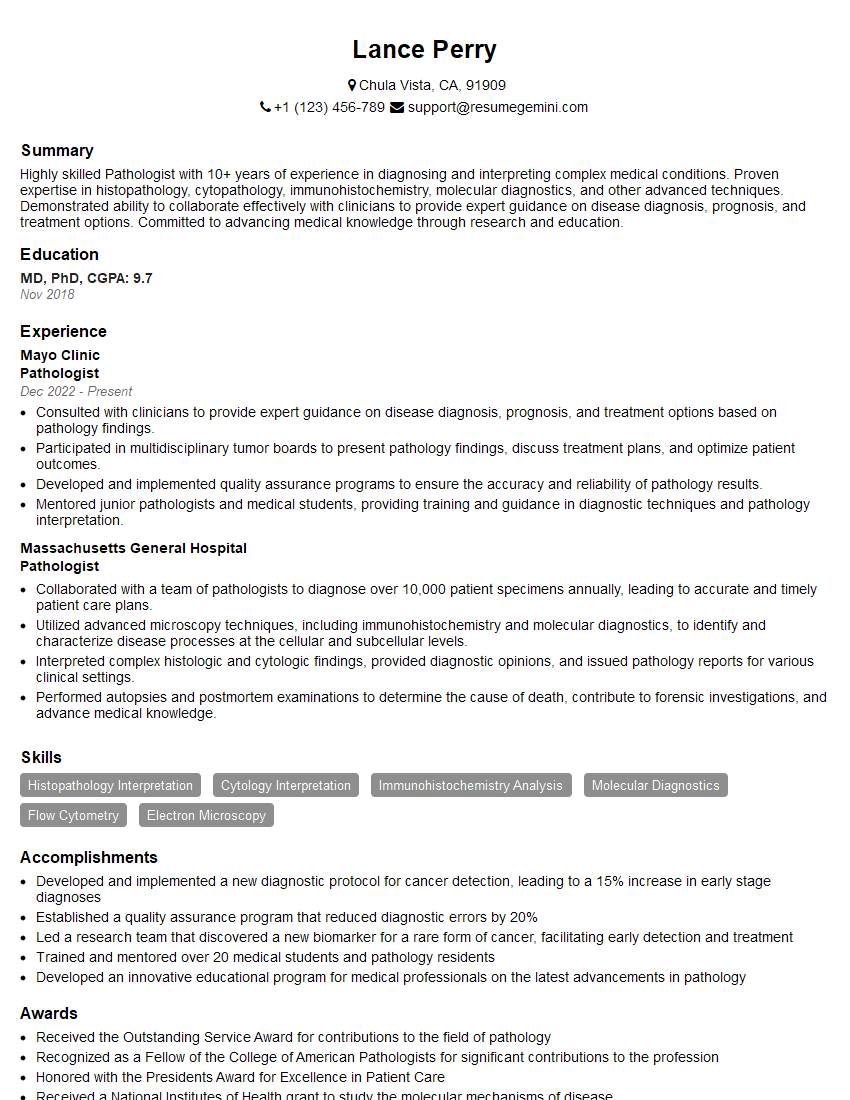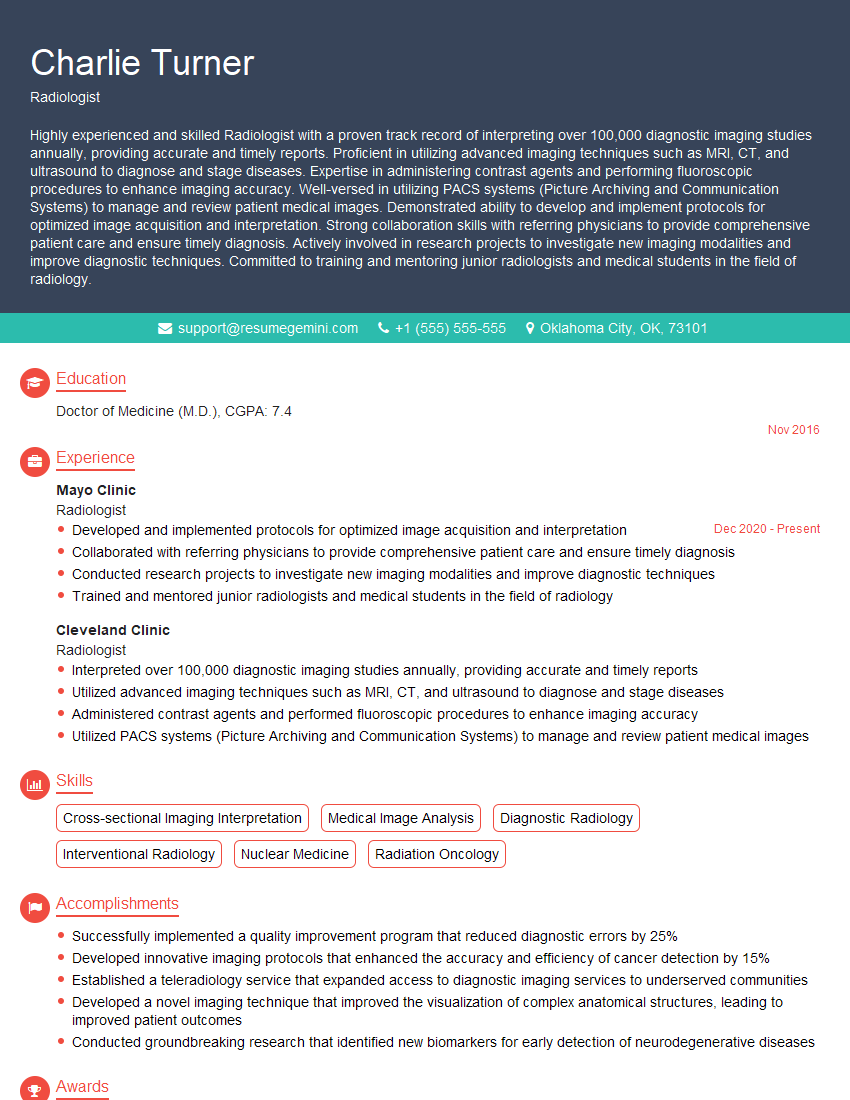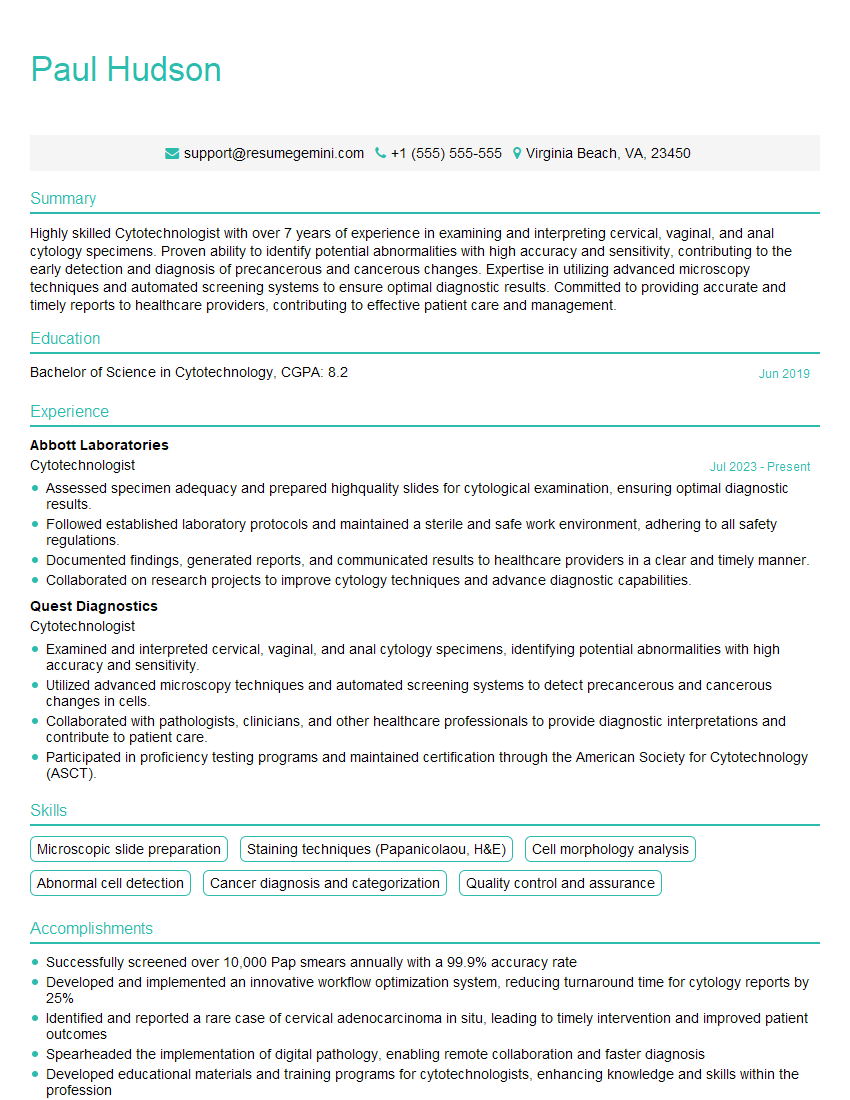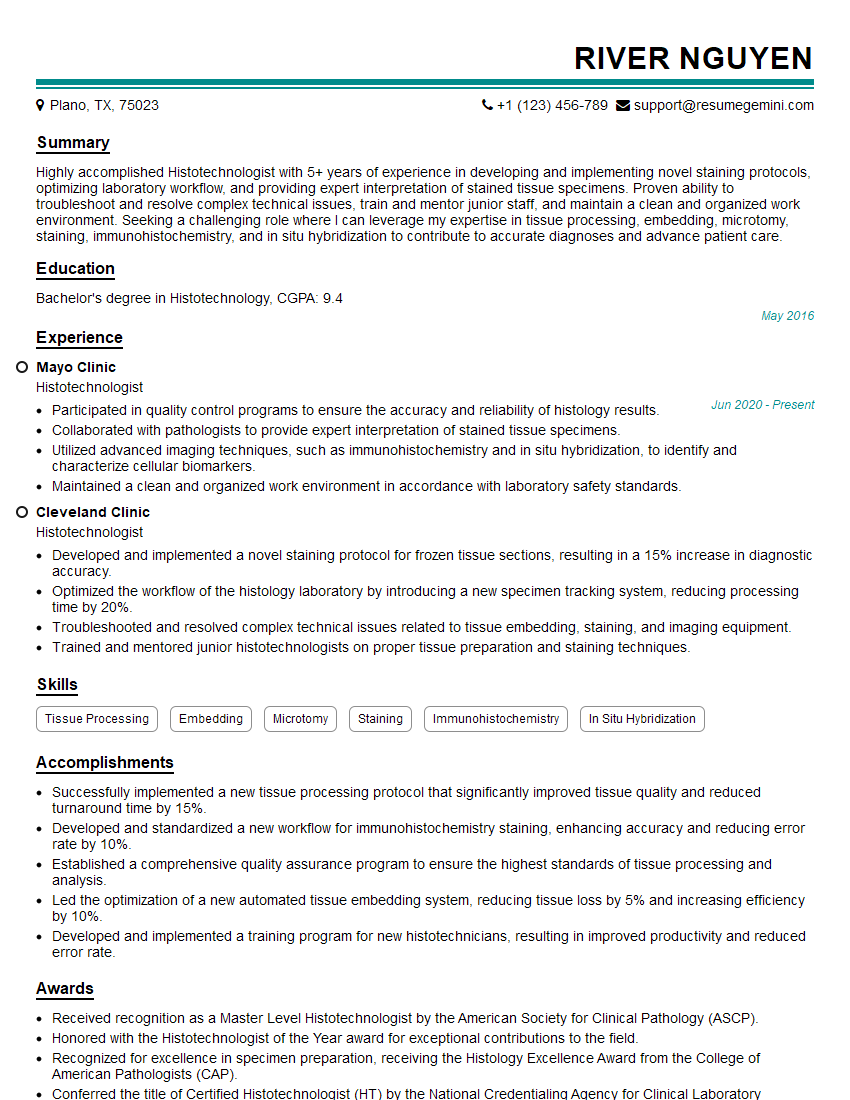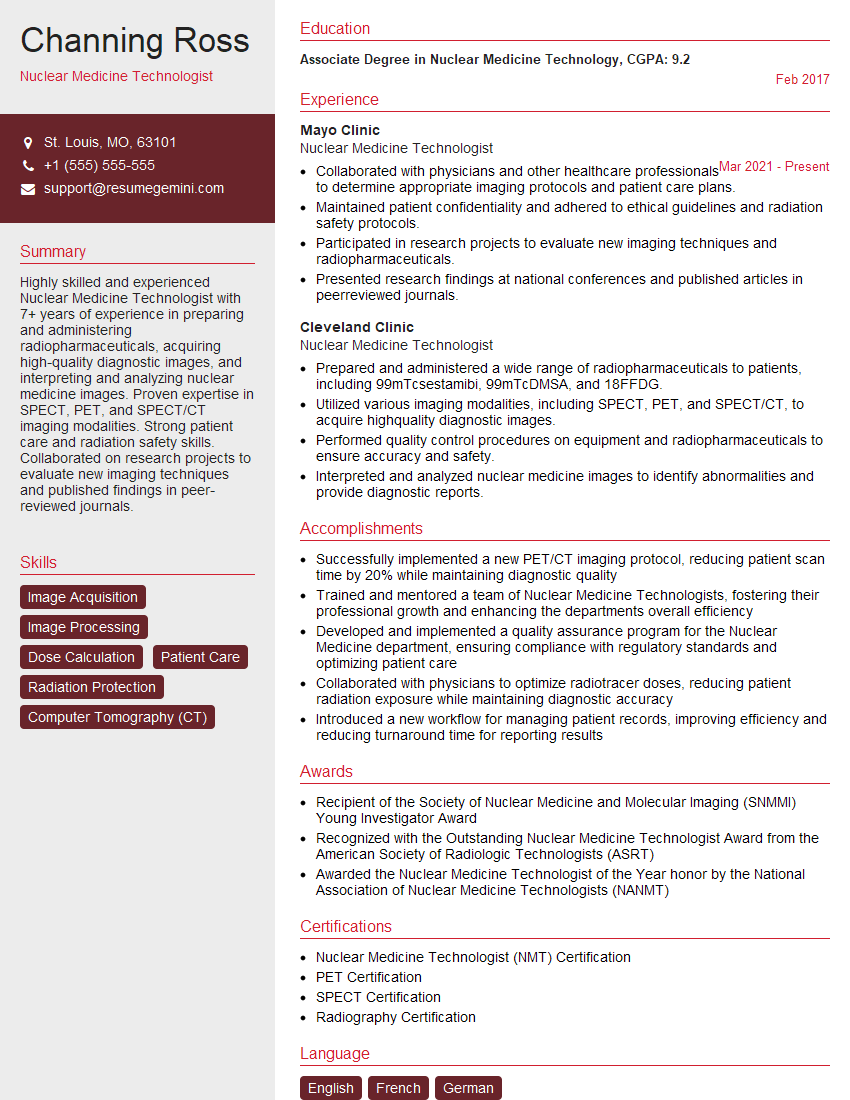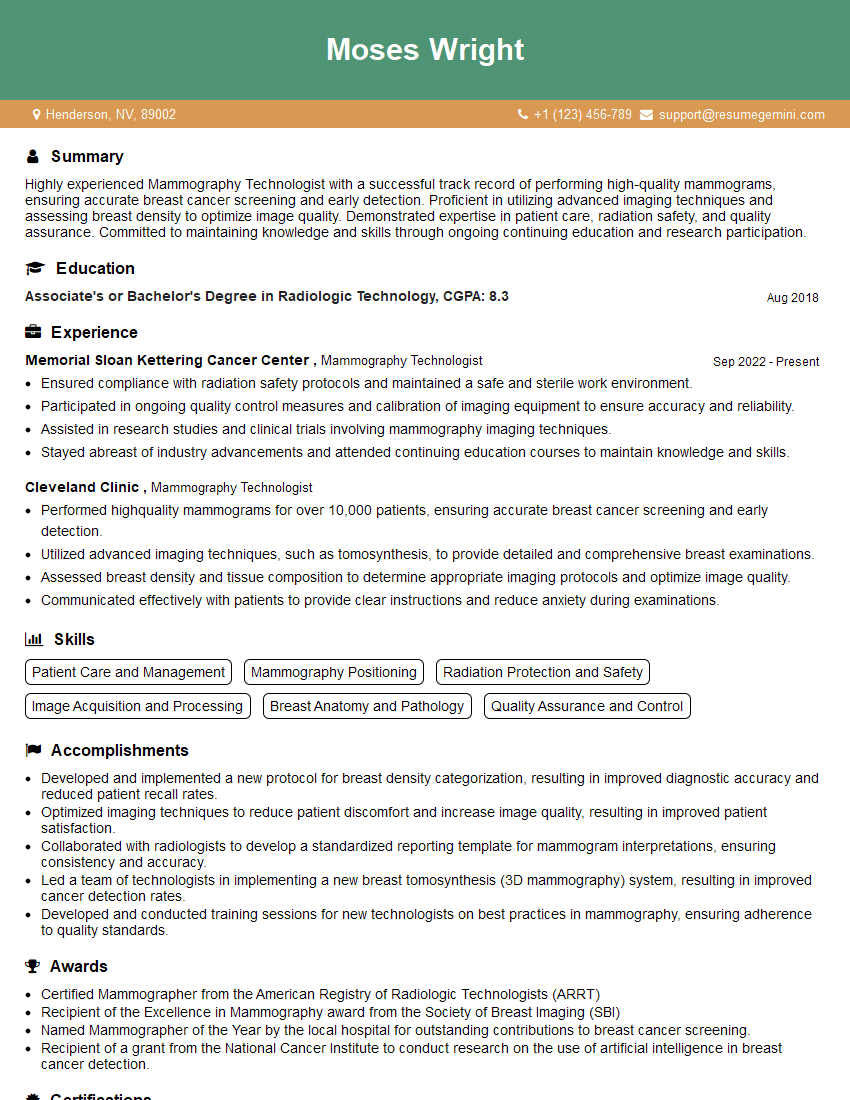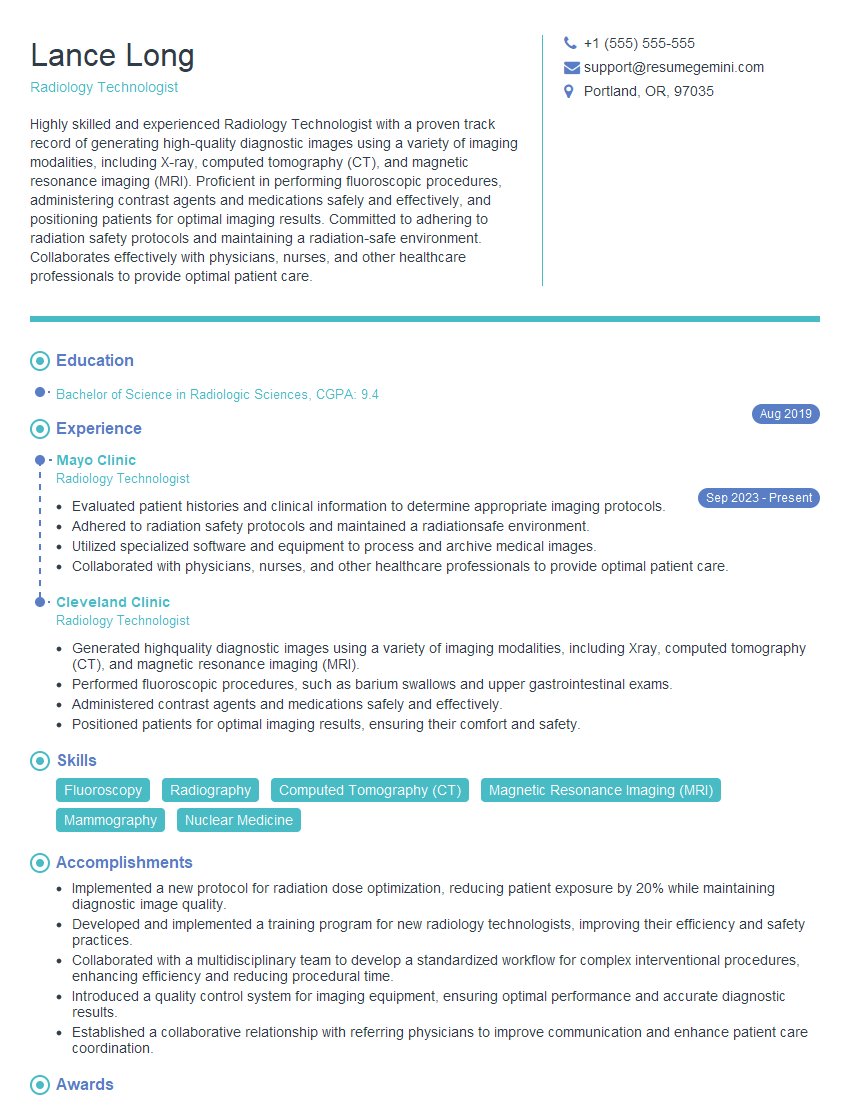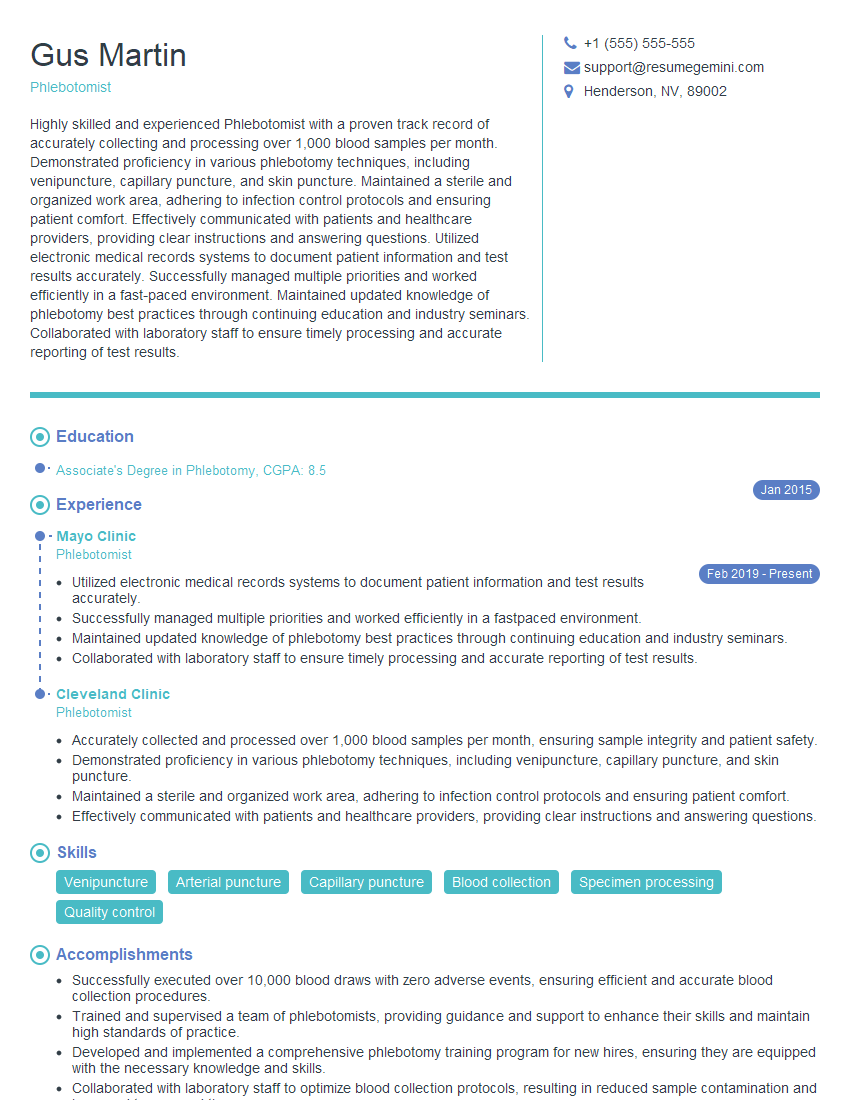The right preparation can turn an interview into an opportunity to showcase your expertise. This guide to Interpretation of Medical Imaging and Laboratory Data interview questions is your ultimate resource, providing key insights and tips to help you ace your responses and stand out as a top candidate.
Questions Asked in Interpretation of Medical Imaging and Laboratory Data Interview
Q 1. Explain the differences between CT, MRI, and X-ray imaging modalities.
X-rays, CT scans, and MRIs are all medical imaging techniques, but they use different principles to create images of the body. X-rays use ionizing radiation to produce a two-dimensional image showing the density of different tissues. Denser tissues like bone appear white, while less dense tissues like air appear black. CT (Computed Tomography) scans use X-rays from multiple angles to create detailed cross-sectional images, providing a 3D view of the body. MRIs (Magnetic Resonance Imaging), on the other hand, utilize a powerful magnetic field and radio waves to produce high-resolution images of soft tissues, providing excellent detail of organs and structures that may be less visible on X-rays or CT scans. Think of it this way: X-rays are like a basic snapshot; CT scans are like a series of detailed cross-sectional maps; and MRIs offer a high-definition, multi-planar view.
- X-ray: Best for visualizing bones, identifying fractures, and detecting foreign bodies.
- CT Scan: Excellent for visualizing internal organs, detecting tumors, assessing trauma, and guiding biopsies.
- MRI: Ideal for imaging soft tissues like the brain, spinal cord, muscles, and ligaments, and identifying subtle abnormalities.
Q 2. Describe the process of interpreting a chest X-ray.
Interpreting a chest X-ray is a systematic process. First, you assess the technical quality – is the image well-exposed? Are there artifacts obscuring any areas? Then, a structured approach is key: I begin by systematically examining each area. I always start with the lungs, assessing for the presence of infiltrates (areas of consolidation or increased opacity), nodules (round lesions), masses (larger, irregular lesions), or pneumothorax (collapsed lung). Next, I examine the heart and mediastinum (the space between the lungs) for any enlargement or masses. The ribs, clavicles, and diaphragm are also inspected for fractures, abnormalities, or elevation. Finally, I look for the presence of any foreign bodies, lines, or tubes. This systematic review, combined with the patient’s clinical history, allows for a proper interpretation. It’s like solving a puzzle – each piece of information contributes to the complete picture.
Q 3. How would you identify and interpret signs of pneumonia on a chest X-ray?
Pneumonia on a chest X-ray typically presents as an airspace opacity, meaning an area of increased density within the lung. This might appear as a consolidation (a dense, hazy area), often lobar (affecting a whole lobe of the lung) or bronchopneumonic (patchy distribution). Sometimes, there will be air bronchograms visible (air-filled bronchi outlined by the surrounding consolidated tissue). The location and pattern of the opacity help determine the type of pneumonia. For instance, a lobar pneumonia may suggest a bacterial infection. However, the radiological findings are not diagnostic on their own; correlation with clinical symptoms and lab results is essential. Imagine the lung as a sponge; pneumonia fills some of the sponge’s pores with fluid and inflammatory cells, obscuring the normal airy appearance.
Q 4. What are the key indicators of a myocardial infarction on an ECG?
A myocardial infarction (heart attack) on an ECG is characterized by specific changes in the ST segment and T wave. ST-segment elevation is a hallmark of a STEMI (ST-elevation myocardial infarction), indicating acute occlusion of a coronary artery. ST-segment depression or T-wave inversion can indicate a non-STEMI (non-ST-elevation myocardial infarction), where the blockage is less severe or affects smaller arteries. Other findings may include the presence of Q waves (abnormal Q waves representing myocardial necrosis) or arrhythmias. However, ECG changes are not always definitive and may require further investigations, such as cardiac enzymes, for confirmation. Think of the ECG as a live monitor of the heart’s electrical activity; changes represent disruptions in this activity, which can be crucial in diagnosing heart attacks.
Q 5. Interpret a given set of complete blood count (CBC) results.
To interpret a CBC (Complete Blood Count), I need the actual numerical values. However, I can discuss how to interpret the key components. A CBC includes:
- White Blood Cell (WBC) count: Elevated WBC counts can suggest infection, inflammation, or leukemia. Low counts can indicate bone marrow suppression.
- Red Blood Cell (RBC) count and Hemoglobin (Hgb): Low counts suggest anemia, which can have various causes.
- Platelet count: Low counts (thrombocytopenia) can increase bleeding risk; high counts (thrombocytosis) can indicate blood clots.
- Differential WBC count: This breaks down the types of WBCs. For example, an increased neutrophil count might suggest a bacterial infection, while an elevated lymphocyte count might point towards a viral infection. This requires looking at percentages of each type of white blood cell.
Without specific numbers, I can’t provide a concrete interpretation. For instance, a WBC count of 15,000/µL along with increased neutrophils suggests an infection, but a WBC of 2,000/µL indicates bone marrow suppression, requiring further investigation.
Q 6. How do you differentiate between bacterial and viral infections based on lab results?
Differentiating bacterial and viral infections based solely on lab results is challenging. Both can cause an elevated WBC count, but the differential can give some clues. A predominantly neutrophilic response often suggests a bacterial infection, while a lymphocytic predominance may indicate a viral infection. However, this is not always the case. More specific tests are needed to confirm the cause. For example, bacterial cultures or PCR (polymerase chain reaction) tests can identify specific bacteria or viruses. Blood cultures can detect bacteria circulating in the bloodstream. The inflammatory markers like CRP and ESR are usually more elevated in bacterial than viral infections, but this isn’t a definitive test. It’s a complex situation and clinical picture is extremely important. Imagine it like detective work; while some clues might point towards a bacterial or viral cause, further investigation is necessary for a definitive diagnosis.
Q 7. Explain the significance of elevated liver enzymes in blood tests.
Elevated liver enzymes, such as ALT (alanine aminotransferase) and AST (aspartate aminotransferase), indicate liver damage or dysfunction. The degree of elevation and the specific enzymes affected provide clues about the cause. For instance, significantly elevated ALT is more specific to liver cell damage. AST, found in the heart and liver, can be elevated in conditions affecting both organs. Causes of elevated liver enzymes range from viral hepatitis and alcohol abuse to drug reactions and autoimmune disorders. Further investigations are necessary to determine the underlying cause. It’s important to remember that mild elevations could be due to many factors including diet or medications, so clinical context and additional testing are crucial. Think of the liver enzymes as warning lights for your liver; their elevation is a signal that something requires attention.
Q 8. What are the common artifacts seen in MRI scans and how do you account for them?
Magnetic Resonance Imaging (MRI) artifacts are distortions or inaccuracies in the image that don’t reflect the true anatomy. They can significantly impact diagnostic accuracy. Understanding their causes is crucial for accurate interpretation.
Susceptibility Artifacts: These arise from variations in magnetic susceptibility across different tissues. For example, air-tissue interfaces (like sinuses or lungs) create significant distortions. They appear as dark streaks or signal loss near these interfaces. We account for them by recognizing their characteristic appearance and considering the anatomical location.
Motion Artifacts: Patient movement during the scan is a common cause of blurring or ghosting. Strategies to mitigate this include sedation, better patient communication, and advanced MRI sequences with motion correction capabilities. We carefully assess the image for signs of motion and may need to repeat the scan if it’s severe.
Chemical Shift Artifacts: These occur due to the different resonant frequencies of fat and water protons. They manifest as a slight shift in the signal, typically seen at fat-water interfaces. We recognize this artifact by its specific appearance and the knowledge that it’s a normal phenomenon.
Metallic Artifacts: Metallic implants, such as dental fillings or orthopedic hardware, can severely distort the MRI signal. These appear as signal voids or streaking. In these cases, we utilize specialized MRI sequences designed to minimize metal artifacts, or if possible, we might consider alternative imaging modalities such as CT.
Accounting for artifacts involves a combination of knowledge of their appearance, understanding of the imaging sequence used, and careful consideration of the patient’s clinical history and other imaging findings. It’s a crucial aspect of accurate MRI interpretation.
Q 9. Describe the role of contrast agents in medical imaging.
Contrast agents are substances administered intravenously to enhance the visibility of specific structures or processes in medical imaging. They work by altering the signal intensity of tissues, making them more distinct from surrounding structures. This is particularly useful in identifying subtle abnormalities.
In CT: Iodine-based contrast agents increase the attenuation of X-rays, resulting in brighter areas on the CT image. This highlights blood vessels, enhancing the visibility of tumors or vascular malformations.
In MRI: Gadolinium-based contrast agents alter the relaxation times of tissues, increasing the signal intensity on T1-weighted images. This is used to visualize areas with increased blood flow, such as tumors or inflammation.
The choice of contrast agent depends on the specific imaging modality and the clinical question. For example, iodine is used in CT for its X-ray attenuating properties, while gadolinium is employed in MRI to alter tissue relaxation times. It’s crucial to assess patient allergies and renal function before administering contrast agents, as complications can arise.
Q 10. What are the limitations of ultrasound imaging?
Ultrasound, while a valuable and widely accessible imaging technique, has its limitations. Its accuracy and ability to visualize structures are affected by several factors.
Dependence on Operator Skill: Ultrasound image quality and interpretation heavily rely on the skill and experience of the sonographer. Suboptimal scanning techniques can lead to inaccurate or incomplete assessments.
Acoustic Shadowing and Enhancement: The presence of air or bone can create acoustic shadowing (regions of signal loss) or enhancement (increased signal intensity), obscuring underlying structures. This makes it challenging to visualize structures behind gas-filled organs (like the lungs) or bone (like the skull).
Limited Penetration: Ultrasound doesn’t penetrate dense structures like bone well, limiting its use in evaluating certain deep-seated pathologies.
Difficulty with Imaging Gas-Filled Structures: Air within the body strongly reflects ultrasound waves, preventing visualization of structures behind gas pockets. This poses challenges in imaging the lungs or bowels.
Operator-Dependent Image Quality: Image quality can vary significantly depending on the skill of the sonographer, the quality of the ultrasound machine, and the patient’s body habitus.
Despite these limitations, ultrasound remains a valuable tool, particularly for its real-time imaging capability, lack of ionizing radiation, and portability.
Q 11. How do you ensure the quality and accuracy of lab results?
Ensuring the quality and accuracy of lab results is paramount for patient safety and effective medical care. This involves a multi-faceted approach.
Pre-analytical Phase: Proper patient identification, correct sample collection, and appropriate handling (e.g., maintaining temperature) are vital. Errors here are a leading cause of inaccurate results.
Analytical Phase: This involves the actual laboratory testing. Calibration of instruments, use of quality control materials, and adherence to established protocols are essential. Regular maintenance and quality control checks ensure instrument accuracy.
Post-analytical Phase: This encompasses the reporting and interpretation of the results. Accurate data entry, appropriate reporting formats, and timely communication with healthcare providers are crucial. Data analysis and comparisons with previous results are also vital for detection of trends.
External Quality Assurance: Participation in proficiency testing programs and external audits helps identify potential issues and improve laboratory performance. This ensures that results are comparable across different laboratories.
A robust quality management system, incorporating these elements, is essential for maintaining the highest standards of laboratory practice and ensuring reliable results.
Q 12. Explain the principles of radiation safety in medical imaging.
Radiation safety in medical imaging is crucial due to the ionizing radiation used in procedures like X-rays and CT scans. The principle is to minimize radiation exposure while obtaining diagnostically useful images.
ALARA Principle: This stands for ‘As Low As Reasonably Achievable.’ All efforts should be made to keep radiation doses to the lowest possible level, balancing the benefits of the exam with the risks of radiation exposure.
Shielding: Lead aprons and shields are used to protect sensitive organs and areas not relevant to the examination from radiation exposure. This is particularly important during fluoroscopy procedures.
Collimation: Restricting the X-ray beam to the area of interest reduces the volume of tissue exposed to radiation. This reduces the overall radiation dose to the patient.
Optimization of Technique: Using appropriate imaging parameters, such as the lowest effective dose of radiation, is crucial for minimizing radiation exposure while maintaining image quality.
Image Post-Processing: Efficient techniques for processing and analyzing images can reduce the need for repeat scans, minimizing radiation exposure.
Regular training for staff on radiation safety protocols is essential. Appropriate dose monitoring for personnel is also crucial.
Q 13. Discuss the ethical considerations related to interpreting medical images and lab data.
Interpreting medical images and lab data involves significant ethical considerations.
Accuracy and Objectivity: The interpretation must be accurate, objective, and free from bias. Personal beliefs or external pressures should not influence the interpretation.
Confidentiality: Patient information must be kept strictly confidential. All communication about findings should adhere to HIPAA and other relevant privacy regulations.
Informed Consent: Patients should be fully informed about the procedure, its benefits, and potential risks before undergoing any imaging or lab test.
Competence: Interpretations should be performed only by qualified and competent professionals. Admitting limitations and seeking consultation when necessary is essential.
Transparency and Communication: Findings must be communicated clearly and transparently to both the patient and referring physician. Complex results may require additional explanation.
Ethical dilemmas may arise when dealing with ambiguous findings, managing conflicting information, or balancing the benefits and risks of a procedure. A strong ethical framework and adherence to professional guidelines are crucial in these situations.
Q 14. How would you handle a discrepancy between imaging findings and clinical presentation?
Discrepancies between imaging findings and clinical presentation are common and necessitate a careful and systematic approach. It’s crucial to avoid jumping to conclusions.
Review the Clinical History: Thoroughly review the patient’s symptoms, medical history, and any relevant clinical information. This could reveal missing clues or alternative explanations.
Re-evaluate the Images: Carefully review the images for any subtle findings that may have been initially overlooked. Consulting with a colleague or specialist can be beneficial.
Consider Alternative Diagnoses: Explore alternative diagnoses that might explain both the imaging findings and the clinical presentation. This often requires correlating the information from various sources.
Further Investigations: Order additional imaging studies (e.g., different sequences, modalities) or lab tests to clarify the discrepancy. This could resolve the issue or provide further evidence.
Correlation with Other Data: Integrate information from other sources, such as previous medical records or results from other investigations. This comprehensive approach aids in accurate diagnosis.
Consult with Specialists: Consult with specialists in relevant fields to gain further expertise and insights. This collaboration improves diagnostic accuracy and therapeutic planning.
Addressing these discrepancies requires a methodical approach, combining clinical judgment, imaging expertise, and a willingness to seek further information when necessary. Remember, the goal is to reach the most accurate diagnosis to guide optimal patient care.
Q 15. Describe your experience with PACS (Picture Archiving and Communication Systems).
My experience with PACS (Picture Archiving and Communication Systems) is extensive. I’ve worked with several different PACS systems throughout my career, including GE Centricity, Siemens Syngo, and Agfa Impax. This involves not just viewing images but also utilizing their functionalities for efficient workflow management. For instance, I’m proficient in using PACS to retrieve, view, and manipulate images from various modalities like CT, MRI, X-ray, and ultrasound. I’m also adept at utilizing advanced features like image annotation, measuring tools, and 3D reconstruction. In a recent project, I used PACS to efficiently manage over 10,000 patient images, optimizing the workflow for radiologists and reducing report turnaround times. My skills extend to troubleshooting common PACS issues, such as network connectivity problems or image display errors, ensuring minimal disruption to clinical operations.
Career Expert Tips:
- Ace those interviews! Prepare effectively by reviewing the Top 50 Most Common Interview Questions on ResumeGemini.
- Navigate your job search with confidence! Explore a wide range of Career Tips on ResumeGemini. Learn about common challenges and recommendations to overcome them.
- Craft the perfect resume! Master the Art of Resume Writing with ResumeGemini’s guide. Showcase your unique qualifications and achievements effectively.
- Don’t miss out on holiday savings! Build your dream resume with ResumeGemini’s ATS optimized templates.
Q 16. Explain your familiarity with various medical imaging software.
My familiarity with medical imaging software extends beyond PACS. I have extensive experience with various image processing and analysis software. This includes both vendor-specific software like those integrated with imaging equipment (e.g., Philips IntelliSpace Portal for analyzing cardiac images) and third-party applications offering advanced image manipulation and analysis (e.g., Osirix for DICOM image viewing and analysis). I’m comfortable using software to perform image enhancement techniques, such as noise reduction and contrast adjustments, crucial for optimizing image interpretation. My experience also encompasses using software for quantitative analysis of images, for example measuring lesion size or calculating bone mineral density from DEXA scans. I regularly utilize software to generate reports and integrate findings into patient electronic health records (EHRs).
Q 17. How would you communicate complex medical imaging findings to a non-medical professional?
Communicating complex medical imaging findings to a non-medical professional requires clear, concise, and empathetic communication. I avoid using technical jargon and instead use analogies and straightforward language. For example, instead of saying ‘there’s a 2cm hypodense lesion in the right hepatic lobe’, I might explain, ‘We see a concerning area in the liver that appears different on the scan, and we need to investigate further.’ I would then use visual aids like simplified diagrams or even point to the specific area on a printed image. I prioritize providing context; I would explain the reason for the imaging, what the scan shows, and the next steps, emphasizing the uncertainties as well as the possibilities. Finally, I would ensure the patient has an opportunity to ask questions and that their concerns are addressed. The goal is to empower them with sufficient information to make informed decisions.
Q 18. Describe your experience with different types of laboratory equipment.
My experience with laboratory equipment spans a wide range of modalities. I’m familiar with the operation and maintenance of various hematology analyzers (like Sysmex XN-series), clinical chemistry analyzers (such as Roche Cobas), immunoassay analyzers (e.g., Siemens ADVIA Centaur), and microbiology equipment (including automated bacterial identification systems). I understand the principles behind each instrument, including calibration, quality control procedures, and troubleshooting. Beyond the operation, I’m also comfortable with preventative maintenance and understanding potential sources of error. For instance, I’ve helped identify and resolve issues with reagent contamination on a chemistry analyzer leading to inaccurate results. This experience allows me to interpret lab results critically, considering pre-analytical, analytical, and post-analytical factors that can affect accuracy.
Q 19. How do you troubleshoot common problems encountered in medical imaging equipment?
Troubleshooting common problems in medical imaging equipment necessitates a systematic approach. I typically follow a structured methodology involving: 1) Identifying the nature of the problem (e.g., image artifacts, equipment malfunction). 2) Checking for simple issues like power supply, network connectivity, or software glitches. 3) Examining error logs and system alerts. 4) Consulting technical manuals and online resources. 5) If necessary, contacting the manufacturer’s technical support for expert assistance. For example, if an MRI machine shows image blurring, I would initially check for patient motion, coil alignment, and sequence parameters. If the problem persists, I’d delve into the system logs for technical issues. Experience with different systems allows for quicker identification of the root cause and efficient problem-solving. My proactive approach includes performing regular preventative maintenance to minimize downtime and ensure the reliability of equipment.
Q 20. How would you ensure patient confidentiality in the context of medical imaging and lab data?
Patient confidentiality is paramount in my work. I adhere strictly to HIPAA regulations and all relevant institutional policies. This includes secure storage of digital images and laboratory data, utilizing password-protected systems and encrypted networks. Access to patient information is restricted to authorized personnel only. I always ensure that patient identifiers are properly masked when images or data are presented for educational or research purposes. Additionally, I’m very careful about discussing patient information only in appropriate settings and never in public areas. Finally, I regularly undergo training on data privacy and security best practices to stay up-to-date on evolving regulations and threats.
Q 21. What is your experience with quality assurance procedures in a medical laboratory setting?
My experience with quality assurance (QA) in a medical laboratory is extensive. I’m familiar with the implementation and monitoring of various QA programs, including proficiency testing, internal quality control, and instrument calibration. I understand the importance of maintaining accurate records and adhering to established protocols. I’ve participated in analyzing quality control data to identify trends and potential problems. For instance, I helped investigate an unexpected increase in the coefficient of variation for a particular blood test, identifying a faulty reagent lot as the root cause, thus preventing inaccurate patient reports. I know that maintaining a rigorous QA program is not only vital for reliable results but also for maintaining accreditation and ensuring patient safety.
Q 22. Describe your approach to interpreting ambiguous or inconclusive results in medical imaging or lab data.
Ambiguous or inconclusive medical imaging or lab results are a common challenge. My approach involves a systematic process. First, I carefully review the entire dataset, including the patient’s history, clinical presentation, and any prior imaging or lab results. This contextual information is crucial for interpretation. Second, I meticulously analyze the images or lab data itself, looking for subtle findings that might have been initially overlooked. This often involves using image manipulation tools (like adjusting brightness/contrast in radiology) or statistical analysis in laboratory data. Third, if the ambiguity persists, I consult relevant literature and guidelines, seeking similar case reports or studies to guide my interpretation. Finally, if necessary, I recommend further investigation, such as repeating the test, ordering additional tests, or referring the patient to a specialist for a second opinion. Think of it like detective work—every clue, no matter how small, matters in piecing together the clinical picture.
For example, an indeterminate lung nodule on CT scan might require a follow-up CT in 6 months to assess for growth, or a PET scan to evaluate metabolic activity. Similarly, borderline abnormal liver function tests might warrant additional serological markers to identify the underlying cause. The key is not to jump to conclusions, but to gather more information until a clear diagnosis can be made.
Q 23. How do you stay current with advancements in medical imaging and laboratory technology?
Staying current in the rapidly evolving fields of medical imaging and laboratory technology is paramount. I actively engage in several strategies. I regularly attend conferences and workshops, both in person and online, to learn about the latest techniques and advances. I also dedicate time to reading peer-reviewed journals and relevant professional publications. This includes subscribing to key journals in radiology, pathology, and clinical laboratory medicine. I actively participate in continuing medical education (CME) programs tailored to these specialities. Additionally, I leverage online resources, such as professional societies’ websites and reputable medical databases, to access the latest research and clinical guidelines. Finally, I collaborate with colleagues and specialists from various disciplines—sharing cases, discussing diagnostic challenges, and learning from each other’s experiences is immensely valuable.
Q 24. Discuss your understanding of different imaging techniques used in oncology.
Oncology imaging utilizes several techniques to detect, stage, and monitor cancer. The choice of technique depends on the type and location of the cancer.
- Computed Tomography (CT): Provides detailed cross-sectional images of the body, identifying tumors and assessing their size, location, and spread to lymph nodes or other organs. CT is often used for staging many cancers, like lung or colorectal.
- Magnetic Resonance Imaging (MRI): Offers superior soft tissue contrast, making it particularly useful for brain tumors, and imaging cancers of the breast, prostate, and gastrointestinal tract.
- Positron Emission Tomography (PET): Uses radioactive tracers to detect metabolically active cells, helping to identify cancerous tissues and differentiating them from benign lesions. PET scans are often used to stage cancers and assess response to therapy.
- Ultrasound: Uses sound waves to produce images, valuable for assessing superficial organs, guiding biopsies, and monitoring treatment response in certain cancers, such as breast or thyroid.
- Nuclear Medicine Imaging (Bone scan): Detects increased bone metabolism, often indicating metastatic spread of cancers like prostate or breast cancer.
In practice, multiple imaging modalities are frequently used in combination to achieve the most comprehensive assessment.
Q 25. How would you interpret a bone scan for metastatic disease?
Interpreting a bone scan for metastatic disease involves looking for areas of increased uptake of the radioactive tracer, indicating increased bone metabolism. These areas appear as “hot spots” on the scan. The location and number of these hotspots are crucial. Multiple lesions suggest widespread disease, while a single lesion might represent a solitary metastasis or even a benign process. The intensity of uptake also provides clues; higher uptake generally suggests more aggressive disease. However, it’s crucial to consider the patient’s clinical history. For instance, a patient with known prostate cancer is more likely to have bone metastases shown as multiple hot spots than a patient with no known malignancy. A single lesion could still warrant further investigation, perhaps with an MRI or biopsy to rule out other possibilities. It’s never simply about the image itself; it’s about the patient in the context of their medical history.
Q 26. How do you differentiate between benign and malignant findings in breast imaging?
Differentiating between benign and malignant findings in breast imaging, primarily mammograms and ultrasound, requires a comprehensive assessment employing several radiological characteristics. Malignant lesions often exhibit irregular margins, spiculated appearance (finger-like projections), and an asymmetric shape. They may show microcalcifications (tiny calcium deposits), which can be clustered or linear in malignant lesions. In contrast, benign lesions usually have smooth, well-defined margins, round or oval shape, and may have characteristics like cyst (fluid-filled). Ultrasound can further characterize lesions by assessing their internal echogenicity (texture) and vascularity (blood flow). However, even with these features, some lesions may be indeterminate, requiring further evaluation, such as a biopsy. The BI-RADS (Breast Imaging Reporting and Data System) assessment categorizes findings to help standardize reporting and guide management. The final diagnosis always relies on tissue analysis from a biopsy.
Q 27. Explain your understanding of different types of blood cell abnormalities and their clinical significance.
Blood cell abnormalities can indicate various underlying conditions. Let’s look at some examples:
- Leukopenia (low white blood cell count): This can result from bone marrow suppression (e.g., due to chemotherapy, certain infections, or autoimmune diseases), or it can be a sign of bone marrow failure. A differential diagnosis needs to be performed in order to understand the cause of low white blood cell count.
- Leukocytosis (high white blood cell count): Usually indicative of infection, inflammation, or leukemia. Further analysis of the differential white blood cell count (to identify the specific types of white blood cells) helps pinpoint the cause. For instance, a high neutrophil count suggests bacterial infection, while a high lymphocyte count might indicate viral infection or lymphoproliferative disorder.
- Anemia (low red blood cell count or hemoglobin): Can be caused by iron deficiency, vitamin B12 or folate deficiency, blood loss, bone marrow disorders, or chronic diseases. Further investigations, like iron studies, vitamin levels, and peripheral blood smear, help determine the etiology.
- Thrombocytopenia (low platelet count): Can be caused by decreased platelet production (e.g., due to bone marrow issues) or increased platelet destruction (e.g., due to autoimmune disease). It often leads to an increased bleeding risk.
- Thrombocytosis (high platelet count): Might be reactive to inflammation or infection, or indicate a myeloproliferative disorder (a group of blood cancers).
Interpreting blood cell abnormalities requires understanding the complete blood count (CBC) and differential, and often necessitates further tests to determine the underlying cause and guide appropriate management. It’s about seeing the blood work in the context of the whole patient picture.
Key Topics to Learn for Interpretation of Medical Imaging and Laboratory Data Interview
- Fundamentals of Medical Imaging: Understanding the principles behind various imaging modalities (X-ray, CT, MRI, Ultrasound) including image acquisition, reconstruction, and limitations. Practical application: Analyzing images to identify anatomical structures and potential pathologies.
- Laboratory Diagnostics: Mastering the interpretation of common blood tests (CBC, CMP, coagulation studies), urinalysis, and other relevant laboratory results. Practical application: Correlating lab findings with clinical presentations and imaging data to reach a differential diagnosis.
- Pathophysiology and Disease Processes: A strong grasp of the underlying mechanisms of diseases relevant to medical imaging and lab data. Practical application: Applying knowledge of pathophysiology to interpret findings and predict disease progression.
- Image Analysis Techniques: Developing skills in identifying key features, recognizing patterns, and differentiating normal from abnormal findings on medical images. Practical application: Systematically assessing images for abnormalities, such as masses, fractures, or inflammation.
- Data Correlation and Clinical Reasoning: Integrating information from various sources (patient history, physical examination, imaging, laboratory data) to formulate a comprehensive understanding of the patient’s condition. Practical application: Building a cohesive clinical picture and making informed decisions.
- Ethical and Legal Considerations: Understanding the implications of interpreting medical data, including patient confidentiality, reporting procedures, and potential legal ramifications. Practical application: Demonstrating responsible and ethical data handling practices.
- Technical Proficiency: Familiarity with relevant software and technologies used in image analysis and data management. Practical application: Demonstrating the ability to use these technologies efficiently and effectively.
Next Steps
Mastering the interpretation of medical imaging and laboratory data is crucial for a successful and rewarding career in healthcare. It allows you to contribute significantly to patient care by providing accurate and timely diagnostic information. To stand out to potential employers, creating a strong, ATS-friendly resume is essential. ResumeGemini is a trusted resource that can help you build a professional resume tailored to highlight your skills and experience. We provide examples of resumes specifically designed for candidates specializing in Interpretation of Medical Imaging and Laboratory Data to help you showcase your qualifications effectively and increase your chances of landing your dream job.
Explore more articles
Users Rating of Our Blogs
Share Your Experience
We value your feedback! Please rate our content and share your thoughts (optional).
What Readers Say About Our Blog
This was kind of a unique content I found around the specialized skills. Very helpful questions and good detailed answers.
Very Helpful blog, thank you Interviewgemini team.


